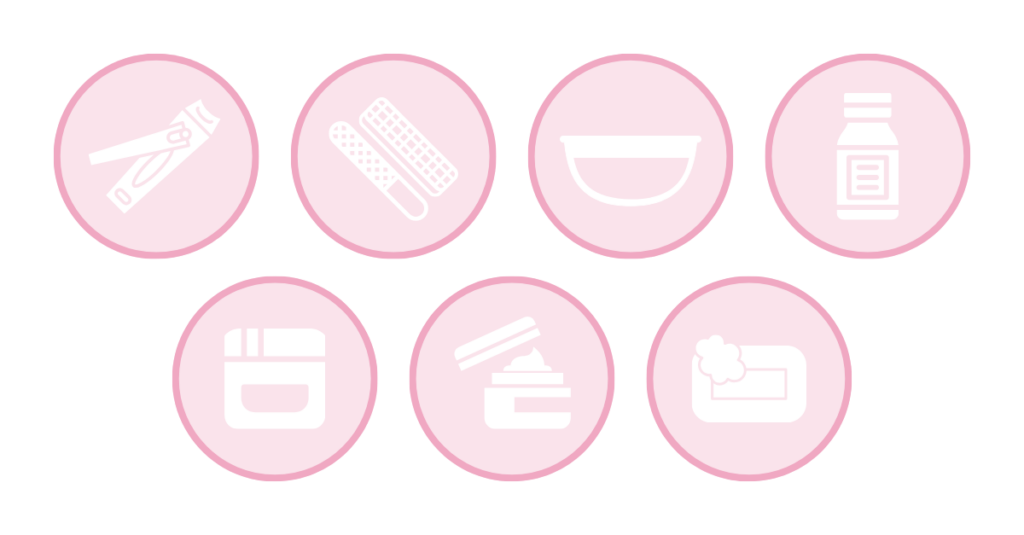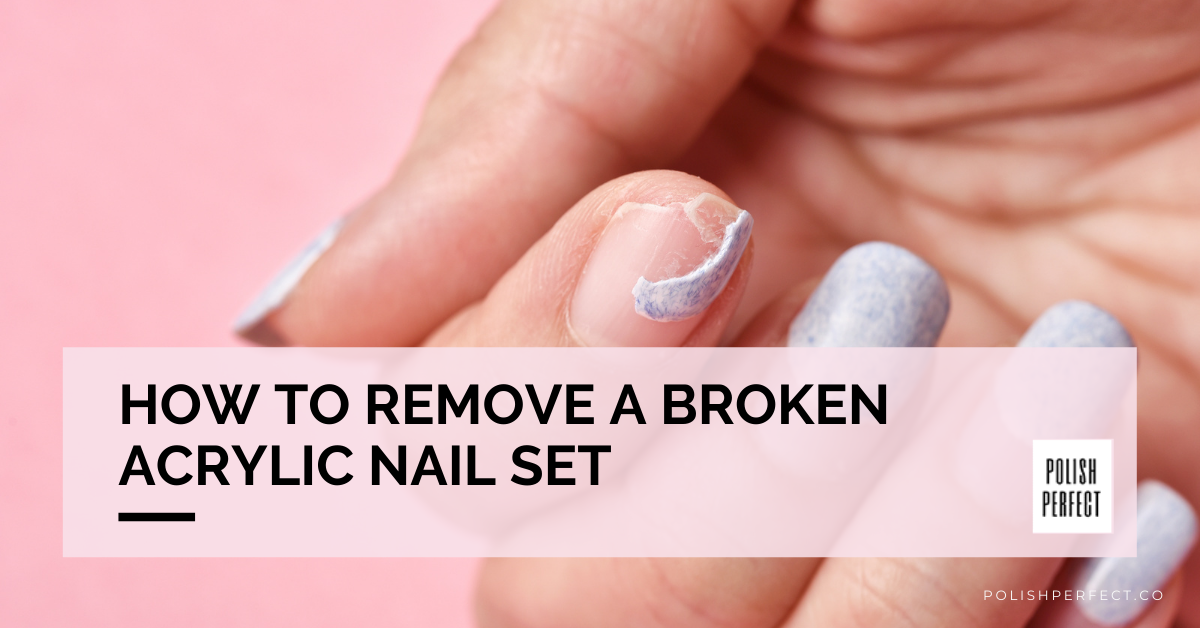We all know how important it is to maintain those beautiful acrylic nails, but accidents happen, and nails just don’t hold up to everyday wear and tear.
So, what do you do when you notice a broken acrylic nail?
Well, step away from the tear-and-remove method. Learn how to remove a broken acrylic nail set without causing damage to the natural nail or your skin.
How to Remove a Broken Acrylic Nail Set

Safely removing a broken acrylic nail set is relatively easy to do by following this tutorial. But before you begin, you may need the following supplies:
- Nail Clipper
- File and/ or Nail Buffer
- Small or Medium-sized Glass Bowl
- Acetone (used for nail polish remover)
- Petroleum Jelly
- Hand Moisturizer
- Soap & Water or Disinfectant
Step-By-Step Instructions on How to Remove a Broken Acrylic Nail Set
Here’s an easy guide on how to remove a broken acrylic nail set that you need to know.
Step 1. Remove the Acrylic
The first step is to remove as much of the broken or lifted acrylic nail as possible. You will likely need a nail clipper and file to perform this step.
Use the nail clipper to carefully clip off the part of the nail and acrylic that need to be removed. Do not use the nail clipper to tear off the acrylic as this can severely damage the natural nail.
If the acrylic nail set is still too thick to clip, then this is where the nail file comes in. Try filing down the nail first before clipping.
If the nail is lifted, sometimes all you need to do is file around the area where the acrylic is lifted to pop the acrylic right off.
Also, try to avoid cutting the nail bed as this will cause bleeding.
Step 2. Use Acetone to Remove the Topcoat
If you have painted acrylic nails, then you may not be able to remove the topcoat or paint simply by filing.
This of course depends on the amount of paint that is still on the nail after the broken or lifted acrylic is removed.
Fill a small or medium-sized bowl halfway with acetone. Then, place the nail into the acetone for several minutes.
If you have sensitive skin, then you may want to consider applying a little petroleum jelly to the skin around your nail after using acetone.
This will help prevent irritation, especially if you have sensitive skin or if you have hangnails.
Note: Acetone is incredibly strong and extremely flammable, so be sure that the room you are working in is well-ventilated.
Step 3. File The Nail
Once the broken acrylic nail set and the top coat are removed, the next step is to file down the natural nail.
Be sure to file and buff out the natural nail as much as possible so that you have a smooth surface to work with once it is time to re-apply the acrylic or repaint.
Although it is important to remove as much of the acrylic nail as possible, try to avoid removing or damaging the natural nail.
Keeping the natural nail intact is important when re-applying acrylic chemicals as they need some of the natural nails to adhere properly.
Step 4. Reshape The Natural Nail
Once you have successfully removed the leftover acrylic, top coat, and paint, and have buffed out the nail until smooth, now you can work on filing and reshaping the nail.
You can use your nail clippers, file, and buffer again to smooth the edges to get the desired shape. While filing and buffing, be sure to move from the base of the nail to the tip. Filing in one direction will avoid damaging the nails.
Step 5. Disinfect
Be sure to disinfect the nail before re-applying acrylic or repainting. You can either use a professional nail disinfectant or soap and water. If you choose to use soap and water, allow the bare nail to sit in the soapy water for up to ten minutes.
This will sanitize the nail and also prevent fungal infections, which is especially important if you are reapplying the acrylic.
Step 6. Re-application
Now that your natural nail is intact and restored to its natural state, you can either reapply the acrylic chemicals or simply paint it as is.
After you have safely removed the broken acrylic nail, you may not want acrylic nails anymore.
However, know that if you have one nail that is in its natural state and the other nine nails are acrylic, it may look a little funny until you remove all acrylics.
If you only have one broken acrylic nail, then you may want to consider fixing it until you are ready to remove the acrylics entirely.
Step 7. Moisturize
The final step—after reapplying acrylic or repainting the nail—is to moisturize. Remember, you just put your nail under a great deal of stress.
You may have also used a number of chemicals to help treat the nail, such as a disinfectant, petroleum jelly, and acetone.
These chemicals can cause severe dryness to the skin. Therefore, the final step is to moisturize by using a simple hand moisturizer.
How To Remove Acrylic with Hot Water
Here is an alternative method for removing acrylic nails.
We all know that removing an acrylic nail set can be a bit of a hassle, but with this hot water technique, the process becomes a breeze.
Before we get started, make sure you have the following items on hand:
- A bowl large enough to comfortably fit your hand.
- Hot water. Not scalding hot, but hot enough to be soothing and relaxing.
- A towel to dry your hands afterward.
- A cuticle pusher or orange stick.
- Nail glue remover or acetone (optional) for removing any residual glue.
Steps to Follow in Removing Acrylic Nails with Hot Water
Now that you have everything you need, let’s walk through the step-by-step process of removing acrylic nails with hot water.
Step 1: Fill a bowl with hot water.
Start by filling a bowl with hot water. Make sure the water is not too hot to avoid scalding your skin. You want it to be comfortably warm.
Step 2: Dip the fingers into a bowl.
Next, carefully dip your fingers into the bowl of hot water. You want to submerge your nails completely, allowing the hot water to soften the acrylic.
Step 3: Soak your fingers.
Now, sit back, relax, and let your fingers soak in the hot water for about 15-30 minutes. This will give the acrylic nails enough time to loosen and become easier to remove.
Step 4: Gently remove the acrylic nails.
After soaking, gently try to remove the fake nails. Start by using a cuticle pusher or an orange stick to gently lift the edges of the acrylic.
If they are ready to come off, they should easily peel away from your natural nails.
If you encounter any resistance or the acrylic nails don’t come off easily, you can repeat the soaking process for another 15-30 minutes and try again.
Step 5: Remove the glue from natural nails.
Once you’ve successfully removed the acrylic nails, you may notice some residual glue on your natural nails.
To remove this, you can use a nail glue remover or acetone. Apply a small amount to a cotton ball or pad and gently rub it over your nails to dissolve the glue.
What To Do If Your Nail Bleeds
Accidents happen, and sometimes we nick our nails a little too close for comfort. If you find yourself in this unfortunate situation, here’s what you need to do:
- Stay Calm And Assess The Damage
First things first, take a deep breath and try not to panic. Assess the situation and determine the severity of the bleeding.
If it’s a minor cut, you might be able to treat it at home. However, if the bleeding is excessive or doesn’t stop after a few minutes, it’s best to seek medical attention.
- Apply Pressure
If the bleeding is manageable, gently apply pressure to the affected area using a clean cloth or tissue. This will help stop the bleeding and promote clotting. Hold the pressure for a few minutes until the bleeding subsides.
- Clean And Disinfect
Once the bleeding has stopped, it’s important to clean and disinfect the wound to prevent infection.
Use a mild antiseptic solution or hydrogen peroxide to gently clean the area. Avoid using alcohol-based products, as they can be too harsh and delay the healing process.
- Bandage It Up
After cleaning the wound, apply a sterile adhesive bandage or a small piece of medical tape to protect the nail and prevent further injury. Make sure the bandage is not too tight, as it can restrict blood flow and impede healing.
- Keep An Eye On It
Monitor the injured nail for any signs of infection, such as redness, swelling, or pus. If you notice any of these symptoms, seek medical attention immediately.
Otherwise, continue to keep the nail clean and dry, and let it heal naturally.
Nail Care Tips After Acrylic Nail Removal
So, your client finally decided to bid farewell to their acrylic nails. Whether it’s because they’re ready for a change or their natural nails need some TLC, it’s important to guide them through the post-acrylic removal care process.
After all, we want their nails to look and feel amazing, right? So, grab your tools, and let’s dive into these nail care tips!
Removing the Remaining Acrylic: The Clean Slate
Once the acrylic nail set is removed, there might be some residue left behind. It’s essential to remove any remaining acrylic to give the natural nails a clean slate. Gently buff the nails using a fine-grit buffer to get rid of the leftover product. Remember to be gentle and avoid excessive buffing, as it can weaken the nails.
Preventing Breaks: Strengthen Those Nails
After acrylic nail removal, the natural nails might be in a fragile state. To prevent breaks and promote healthy nail growth, recommend your clients follow these tips:
- Moisturize, Moisturize, Moisturize: Dry nails are more prone to breakage. Encourage your clients to moisturize their nails and cuticles regularly.
Good cuticle oil or cream can work wonders in keeping the nails hydrated and healthy.
- Nail Strengthening Products: Suggest the use of nail strengthening products that contain ingredients like keratin or biotin.
These ingredients help fortify the nails and promote growth. Just remind your clients that consistency is key!
- Avoid Harsh Chemicals: Harsh chemicals, such as acetone-based nail polish removers, can be drying to the nails.
Suggest using gentle, acetone-free removers instead. And when it comes to cleaning products, recommend your clients wear gloves to protect their nails from harsh chemicals.
- Nail-Friendly Diet: A balanced diet rich in vitamins and minerals can do wonders for nail health. Encourage your clients to include foods like leafy greens, eggs, nuts, and fish in their diet to support strong and healthy nails.
Have Patience: The Waiting Game
Speaking of patience, it’s important to stress that it takes time for the nails to fully recover after acrylic nail set removal. On average, nails grow about 1/8 inch per month, so it might take a few months for the nails to regain their strength and shape.
Encourage your clients to be patient and resist the urge to rush the process.
Remember that proper nail care after acrylic nail set removal is crucial for healthy, strong nails. Guide your clients through the process of removing any remaining acrylic, preventing breaks, and having patience.
By following these tips, your clients will be well on their way to rocking their natural nails with confidence!
Keep Your Acrylic Nails Looking Great
We hope that you found this tutorial on how to remove a broken acrylic nail set helpful and easy to follow.
All in all, it’s important for the acrylics wearer to maintain acrylic nails as much as possible to not only keep the nails looking great but also to maintain the health of the nails and skin.
Therefore, if an acrylic nail set breaks, you now know the proper steps to treat it and safely remove a broken acrylic nail.
Do you know how to take off a broken acrylic nail set? Or have you tried another process? We’d love to hear about it! Please share your thoughts and comments below.
More Related Resources:



